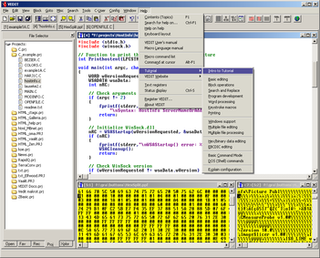Contents
| Look up edit in Wiktionary, the free dictionary. |
Edit may refer to:
| Look up edit in Wiktionary, the free dictionary. |
Edit may refer to:
Edlin is a line editor, and the only text editor provided with early versions of IBM PC DOS, MS-DOS and OS/2. Although superseded in MS-DOS 5.0 and later by the full-screen MS-DOS Editor, and by Notepad in Microsoft Windows, it continues to be included in the 32-bit versions of current Microsoft operating systems.

Microsoft Word is a word processor developed by Microsoft. It was first released on October 25, 1983, under the name Multi-Tool Word for Xenix systems. Subsequent versions were later written for several other platforms including IBM PCs running DOS (1983), Apple Macintosh running the Classic Mac OS (1985), AT&T UNIX PC (1985), Atari ST (1988), OS/2 (1989), Microsoft Windows (1989), SCO Unix (1990), and macOS (2001).

WordPerfect (WP) is a word processing application, now owned by Corel, with a long history on multiple personal computer platforms. At the height of its popularity in the 1980s and early 1990s, it was the dominant player in the word processor market, displacing the prior market leader WordStar.

WordStar is a word processor application for microcomputers. It dominated the market in the early and mid-1980s, succeeding the market leader Electric Pencil. It was published by MicroPro International, originally written for the CP/M-80 operating system, and later written also for MS-DOS and other 16-bit PC OSes. Seymour I. Rubinstein was the principal owner of the company, and Rob Barnaby was the sole author of the early versions of the program. Starting with WordStar 4.0, the program was built on new code written principally by Peter Mierau.

COMMAND.COM is the default command-line interpreter for MS-DOS, Windows 95-98, Windows 98SE and Windows Me. In the case of DOS, it is the default user interface as well. It has an additional role as the usual first program run after boot, hence being responsible for setting up the system by running the AUTOEXEC.BAT configuration file, and being the ancestor of all processes.
In human–computer interaction and user interface design, cut, copy, and paste are related commands that offer an interprocess communication technique for transferring data through a computer's user interface. The cut command removes the selected data from its original position, while the copy command creates a duplicate; in both cases the selected data is kept in temporary storage. The data from the clipboard is later inserted wherever a paste command is issued. The data remains available to any application supporting the feature, thus allowing easy data transfer between applications.
An HTML editor is a program for editing HTML, the markup of a web page. Although the HTML markup in a web page can be controlled with any text editor, specialized HTML editors can offer convenience and added functionality. For example, many HTML editors handle not only HTML, but also related technologies such as CSS, XML and JavaScript or ECMAScript. In some cases they also manage communication with remote web servers via FTP and WebDAV, and version control systems such as Subversion or Git. Many word processing, graphic design and page layout programs that are not dedicated to web design, such as Microsoft Word or Quark XPress, also have the ability to function as HTML editors.
Print or printing commonly refers to:

In computing, configuration files are files used to configure the parameters and initial settings for some computer programs. They are used for user applications, server processes and operating system settings.

DOSKEY is a command for DOS, IBM OS/2, Microsoft Windows, and ReactOS that adds command history, macro functionality, and improved editing features to the command-line interpreters COMMAND.COM and cmd.exe.

MS-DOS Editor, commonly just called edit or edit.com, is a TUI text editor that comes with MS-DOS 5.0 and later, as well as all "x86" SKUs of Windows, until Windows 11. It supersedes edlin, the standard editor in earlier versions of MS-DOS. In MS-DOS, it was a stub for QBasic running in editor mode. Starting with Windows 95, MS-DOS Editor became a standalone program because QBasic didn't ship with Windows.
Raster graphics editors can be compared by many variables, including availability.
In computing, SUBST is a command on the DOS, IBM OS/2, Microsoft Windows and ReactOS operating systems used for substituting paths on physical and logical drives as virtual drives.
An editor is a person who edits documents or audio-visual works. The term can also apply to software and hardware tools used to accomplish such changes.
The SemWare Editor (TSE) is a text editor computer program for MS-DOS, OS/2, and Windows.

Vedit is a commercial text editor for 8080/Z-80-based systems, Microsoft Windows and MS-DOS from Greenview Data, Inc.

QBasic is an integrated development environment (IDE) and interpreter for a variety of dialects of BASIC which are based on QuickBASIC. Code entered into the IDE is compiled to an intermediate representation (IR), and this IR is immediately interpreted on demand within the IDE.

A command-line interface (CLI) processes commands to a computer program in the form of lines of text. The program which handles the interface is called a command-line interpreter or command-line processor. Operating systems implement a command-line interface in a shell for interactive access to operating system functions or services. Such access was primarily provided to users by computer terminals starting in the mid-1960s, and continued to be used throughout the 1970s and 1980s on VAX/VMS, Unix systems and personal computer systems including DOS, CP/M and Apple DOS.